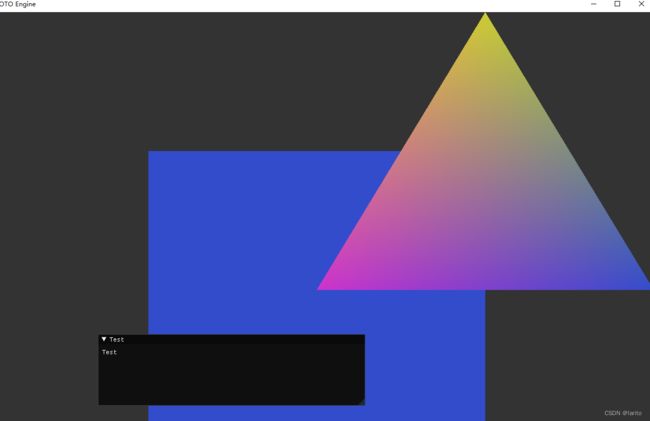跟着cherno手搓游戏引擎【15】DrawCall的封装
目标:
Application.cpp:把渲染循环里的glad代码封装成自己的类:
#include"ytpch.h"
#include "Application.h"
#include"Log.h"
#include "YOTO/Renderer/Renderer.h"
#include"Input.h"
namespace YOTO {
#define BIND_EVENT_FN(x) std::bind(&x, this, std::placeholders::_1)
Application* Application::s_Instance = nullptr;
Application::Application() {
YT_CORE_ASSERT(!s_Instance, "Application需要为空!")
s_Instance = this;
//智能指针
m_Window = std::unique_ptr(Window::Creat());
//设置回调函数
m_Window->SetEventCallback(BIND_EVENT_FN(Application::OnEvent));
//new一个Layer,放在最后层进行渲染
m_ImGuiLayer = new ImGuiLayer();
PushOverlay(m_ImGuiLayer);
//unsigned int id;
//glGenBuffers(1, &id);
uint32_t indices[3] = { 0,1,2 };
float vertices[3 * 7] = {
-0.5f,-0.5f,0.0f, 0.8f,0.2f,0.8f,1.0f,
0.5f,-0.5f,0.0f, 0.2f,0.3f,0.8f,1.0f,
0.0f,0.5f,0.0f, 0.8f,0.8f,0.2f,1.0f,
};
m_VertexArray.reset(VertexArray::Create());
std::shared_ptr m_VertexBuffer;
m_VertexBuffer.reset(VertexBuffer::Create(vertices, sizeof(vertices)));
{
BufferLayout setlayout = {
{ShaderDataType::Float3,"a_Position"},
{ShaderDataType::Float4,"a_Color"}
};
m_VertexBuffer->SetLayout(setlayout);
}
m_VertexArray->AddVertexBuffer(m_VertexBuffer);
std::shared_ptrm_IndexBuffer;
m_IndexBuffer.reset(IndexBuffer::Create(indices, sizeof(indices)/sizeof(uint32_t)));
m_VertexArray->AddIndexBuffer(m_IndexBuffer);
std::string vertexSource = R"(
#version 330 core
layout(location = 0) in vec3 a_Position;
layout(location = 1) in vec4 a_Color;
out vec3 v_Position;
out vec4 v_Color;
void main(){
v_Position=a_Position;
v_Color=a_Color;
gl_Position =vec4( a_Position+0.5,1.0);
}
)";
//绘制颜色
std::string fragmentSource = R"(
#version 330 core
layout(location = 0) out vec4 color;
in vec3 v_Position;
in vec4 v_Color;
void main(){
color=vec4(v_Color);
}
)";
m_Shader.reset(new Shader(vertexSource, fragmentSource));
///测试/
m_SquareVA.reset(VertexArray::Create());
float squareVertices[3 * 4] = {
-0.5f,-0.5f,0.0f,
0.5f,-0.5f,0.0f,
0.5f,0.5f,0.0f,
-0.5f,0.5f,0.0f
};
std::shared_ptr squareVB;
squareVB.reset(VertexBuffer::Create(squareVertices, sizeof(squareVertices)));
squareVB->SetLayout({
{ShaderDataType::Float3,"a_Position"}
});
m_SquareVA->AddVertexBuffer(squareVB);
uint32_t squareIndices[6] = { 0,1,2,2,3,0 };
std::shared_ptr squareIB;
squareIB.reset((IndexBuffer::Create(squareIndices, sizeof(squareIndices) / sizeof(uint32_t))));
m_SquareVA->AddIndexBuffer(squareIB);
//测试:
std::string BlueShaderVertexSource = R"(
#version 330 core
layout(location = 0) in vec3 a_Position;
out vec3 v_Position;
void main(){
v_Position=a_Position;
gl_Position =vec4( a_Position,1.0);
}
)";
//绘制颜色
std::string BlueShaderFragmentSource = R"(
#version 330 core
layout(location = 0) out vec4 color;
in vec3 v_Position;
void main(){
color=vec4(0.2,0.3,0.8,1.0);
}
)";
m_BlueShader.reset(new Shader(BlueShaderVertexSource, BlueShaderFragmentSource));
}
Application::~Application() {
}
///
/// 所有的Window事件都会在这触发,作为参数e
///
///
void Application::OnEvent(Event& e) {
//根据事件类型绑定对应事件
EventDispatcher dispatcher(e);
dispatcher.Dispatch(BIND_EVENT_FN(Application::OnWindowClosed));
//输出事件信息
YT_CORE_INFO("Application:{0}",e);
for (auto it = m_LayerStack.end(); it != m_LayerStack.begin();) {
(*--it)->OnEvent(e);
if (e.m_Handled)
break;
}
}
bool Application::OnWindowClosed(WindowCloseEvent& e) {
m_Running = false;
return true;
}
void Application::Run() {
WindowResizeEvent e(1280, 720);
if (e.IsInCategory(EventCategoryApplication)) {
YT_CORE_TRACE(e);
}
if (e.IsInCategory(EventCategoryInput)) {
YT_CORE_ERROR(e);
}
while (m_Running)
{
/* glClearColor(0.2f, 0.2f, 0.2f,1);
glClear(GL_COLOR_BUFFER_BIT);*/
RenderCommand::SetClearColor({0.2f, 0.2f, 0.2f, 1.0f});
RenderCommand::Clear();
Renderer::BeginScene();
{
m_BlueShader->Bind();
Renderer::Submit(m_SquareVA);
m_Shader->Bind();
Renderer::Submit(m_VertexArray);
Renderer::EndScene();
}
//m_BlueShader->Bind();
//m_SquareVA->Bind();
//glDrawElements(GL_TRIANGLES, m_SquareVA->GetIndexBuffer()->GetCount(), GL_UNSIGNED_INT, nullptr);
glBindVertexArray(m_VertexArray);
//m_Shader->Bind();
//m_VertexArray->Bind();
//glDrawElements(GL_TRIANGLES,m_VertexArray->GetIndexBuffer()->GetCount(),GL_UNSIGNED_INT,nullptr);
for (Layer* layer : m_LayerStack) {
layer->OnUpdate();
}
//将ImGui的刷新放到APP中,与Update分开
m_ImGuiLayer->Begin();
for (Layer* layer : m_LayerStack) {
layer->OnImGuiRender();
}
m_ImGuiLayer->End();
m_Window->OnUpdate();
}
}
void Application::PushLayer(Layer* layer) {
m_LayerStack.PushLayer(layer);
layer->OnAttach();
}
void Application::PushOverlay(Layer* layer) {
m_LayerStack.PushOverlay(layer);
layer->OnAttach();
}
} 抽象:
RendererAPI.h:渲染API的抽象,包括API实现的功能都封装一下:
#pragma once
#include
#include "VertexArray.h"
namespace YOTO {
class RendererAPI
{
public:
enum class API {
None = 0,
OpenGL = 1
};
public:
virtual void SetClearColor(const glm::vec4& color)=0;
virtual void Clear() = 0;
virtual void DrawIndexed(const std::shared_ptr& vertexArray)=0;
inline static API GetAPI() { return s_API; }
private:
static API s_API;
};
}
RendererAPI.cpp:给当前API赋值:
#include "ytpch.h"
#include "RendererAPI.h"
namespace YOTO {
RendererAPI::API RendererAPI::s_API = RendererAPI::API::OpenGL;
}实现:
OpenGLRendererAPI.h:实现接口,制定重写方法,在cpp中封账glad代码:
#pragma once
#include"YOTO/Renderer/RendererAPI.h"
namespace YOTO {
class OpenGLRendererAPI:public RendererAPI
{
public:
virtual void SetClearColor(const glm::vec4& color)override;
virtual void Clear()override;
virtual void DrawIndexed(const std::shared_ptr& vertexArray) override;
};
}
OpenGLRendererAPI.cpp:
#include "ytpch.h"
#include "OpenGLRendererAPI.h"
#include
namespace YOTO {
void OpenGLRendererAPI::SetClearColor(const glm::vec4& color)
{
glClearColor(color.r, color.g, color.b, color.a);
}
void OpenGLRendererAPI::Clear()
{
glClear(GL_COLOR_BUFFER_BIT | GL_DEPTH_BUFFER_BIT);
}
void OpenGLRendererAPI::DrawIndexed(const std::shared_ptr& vertexArray)
{
glDrawElements(GL_TRIANGLES, vertexArray->GetIndexBuffer()->GetCount(), GL_UNSIGNED_INT, nullptr);
}
} 调用:
RenderCommand.h:根据当前API调用API的一些通用方法:
#pragma once
#include"RendererAPI.h"
namespace YOTO {
class RenderCommand
{
public:
inline static void SetClearColor(const glm::vec4& color) {
s_RendererAPI->SetClearColor(color);
}
inline static void Clear() {
s_RendererAPI->Clear();
}
inline static void DrawIndexed(const std::shared_ptr& vertexArray) {
s_RendererAPI->DrawIndexed(vertexArray);
}
private:
static RendererAPI* s_RendererAPI;
};
}
RenderCommand.cpp:(个人觉得应该在new的时候再给API的枚举赋值,在 RendererAPI
.cpp中导致可以new 其他API枚举选另一个API)(不知道后面会不会改)
#include "ytpch.h"
#include "RenderCommand.h"
#include"Platform/OpenGL/OpenGLRendererAPI.h"
namespace YOTO {
RendererAPI* RenderCommand::s_RendererAPI = new OpenGLRendererAPI;
}Renderer.h: 对command的一些方法进行进一步封装,并拓展出Begin和End方法:
#pragma once
#include"RenderCommand.h"
namespace YOTO {
class Renderer {
public:
static void BeginScene();
static void EndScene();
static void Submit(const std::shared_ptr& vertexArray);
inline static RendererAPI::API GetAPI() {
return RendererAPI::GetAPI();
}
};
} Renderer.cpp:
#include"ytpch.h"
#include"Renderer.h"
namespace YOTO {
void Renderer::BeginScene()
{
}
void Renderer::EndScene()
{
}
void Renderer::Submit(const std::shared_ptr& vertexArray)
{
vertexArray->Bind();
RenderCommand::DrawIndexed(vertexArray);
}
} 修改:
所有switch的枚举都改成这样(会报错,报了再改也行)
RendererAPI::API::OpenGL:测试:
原汁原味儿~能跑出来就对了!
